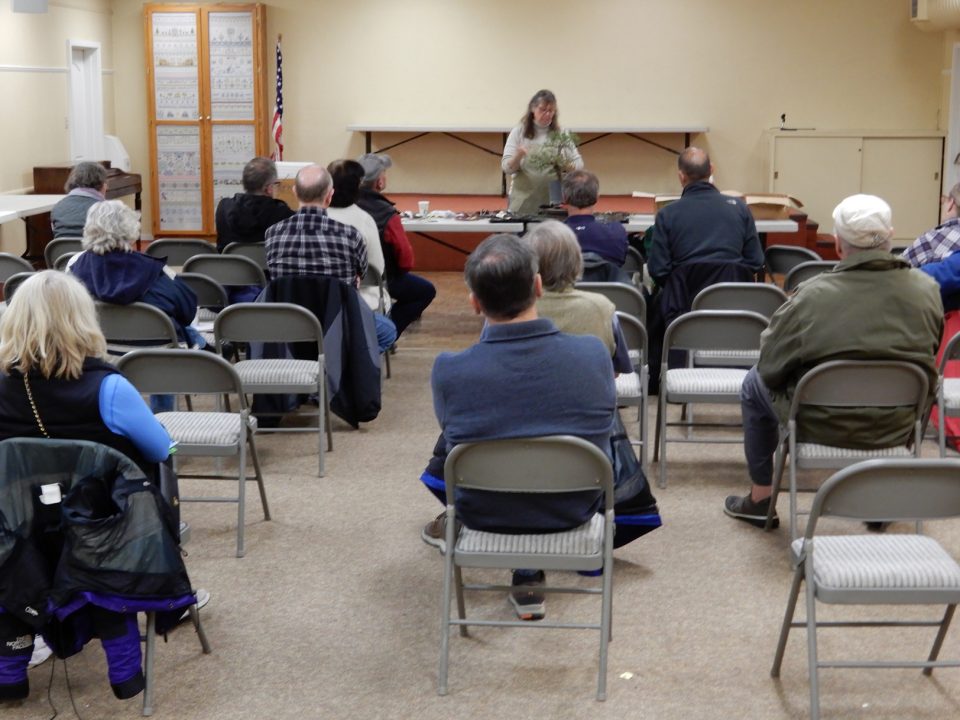REBS was privileged to have internationally acclaimed bonsai artist Boon Manakitivipart present the program at our May 26, 2022 meeting. Boon gave us a bit of his personal bonsai history as an introduction, detailing his first frustrating efforts in the 1980’s to even get his trees to live, and his opportunities beginning in the early 1990’s to study in Japan and learn from masters there. Boon spoke of apprenticing in gardens that specialized in Japanese Black Pines and the wealth of high quality material there to study and work on. During his training he had the opportunity to work on several trees that subsequently won top prizes at the Kokufu show in Japan. He has carried this love and study of JBP and bonsai in general to his work in the US at his gardens outside Sacramento, California.
Boon worked on three trees during his presentation, the first an olive. He explained that olives with big leaves are referred to as Mission Olives or Common Olives. These will bear fruit, but those with small leaves do not. Olives are easy to collect locally in old orchards or neighbors’ yards, and if you have a good trunk of a common olive the smaller foliage of the small leaved variety can be grafted on from cuttings. In the wild olives have no shape to the foliage, they just look shaggy, but they can have wonderful chunky trunks which make dramatic bonsai when the branches are directed with wire. Branches are grown out for girth and pruned to the desired shape when the tree is full and healthy. On more mature trees pinching will help keep the tree in shape, but Boon warned not to take all the new growth off. When pinching and cutting back in the spring it is important to leave some growing tips so the branch won’t die. During spring cleanup old leaves and downward pointing leaves can be removed to better show good branching and ramification. Also be sure to remove the suckers on the trunk. In styling an olive Boon suggests leaving the top a little fuller. Overall, the ideal is a triangular shape with a slightly rounded top, and it is important to keep the tree looking balanced.
In his bonsai journey finding the right potting soil for his trees was a big challenge for Boon. Now we have easy access to Akadama clay from Japan and premixed soils with lava and pumice as well, but when Boon started those materials were not available in the US and the prevailing “wisdom” here was to include some organics in the soil mix, like orchid bark or peat moss. His trees were failing because the soil became too wet, compromising the health of the trees, so he read everything he could find about soil, including every issue of Bonsai Today from the very beginning of its publication. It took years of experimenting with many combinations before Boon found the blend he favors, which is Akadama/lava/pumice with about 5% decomposed granite. This last ingredient is similar to the sand the Japanese refer to in their mixes. Boon includes it based on his observations of the natural habitat of junipers and pines in the mountains where they grow well in granite.
The second tree Boon worked on was a small, healthy shimpaku juniper. He used this tree to illustrate the importance of balancing growth in a bonsai and keeping the tree developing new branches with proper pruning techniques. Boon was cutting the long shoots on this tree at this time pointing out how evenly distributed they were on the tree which indicates optimal, balanced growth. He was not going through the tree taking off all the green tips. Long ago this was what local teachers recommended, but it stunted the growth of trees because these growing tips are what is needed to keep the tree vibrant and healthy. You also don’t want to prune a juniper, or any tree, at the wrong time which can also slow the growth or result in branches dying off. Boon mentioned that many bonsai hobbyists work on their trees too much or take off too many of the important growing tips. The result is prickly juvenile growth which is usually not desired, and little or no branch development. If this has happened on our trees, he suggests letting them grow out for at least a year and starting again with the pruning when the mature growth has returned. Weaker branches should be allowed to grow without pruning.
Boon saved the raffle tree for last, an olive whose trunk is a “nice chunk of lumber”. This is a collected common olive with the larger leaves, but Boon had grafted cuttings of a smaller leaf olive in strategic places on the branches. He talked about the 30-40 year old tree and how the trunk could be made to look older and given more character with some carving. He recommends hand tools which encourages a slow approach, stepping back and reviewing the work before moving on, resulting in a more natural look. The grafts had pieces of blue painters’ tape on them which acts as shade cloth for the graft and keeps them moist as they grow. Boon suggested we all need to learn to let our trees grow, not overwork them and allow them to have a more natural aspect. The ultimate goal for this tree is to make it look like it came from the mountains.
Diane Matzen was the lucky winner of the raffle and picked up a few more growing tips at Boon’s workshop the next day. We want to thank Boon for an inspiring talk and sharing his expertise and wisdom with us.
Write up by Candace Key








Photographs and captions by Michael Murtaugh



































